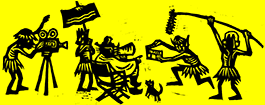|
| |
 |
|
|
| |
 |
鳳甲美術館 Hong-Gah Museum
|
台北市11268北投區大業路166號11樓(近捷運淡水線奇岩站)
開放時間 Open Hours 10:30-17:30(週一休館 Closed on Monday)
11F., No. 166, Daye Road, Beitou District, Taipei City 11268, Taiwan
TEL 886-2-28942272︱www.hong-gah.org.tw
|
|
| |
| |
|
 |
|
| |
| 迪耶哥.拉米瑞茲 |
|
| 墨西哥 |
|
蘿蔔
2013,單頻錄像,4分20秒
|
|
| Diego Ramirez |
|
| Mexico |
|
Radish
2013, single-channel video, 4'20" |
|
|
|
|
| 迪耶哥.拉米瑞茲畢業於墨爾本皇家理工大學,其作品融合了對於自然史、墨西哥殖民時代文化以及流行文化的觀察;在他的影像作品中,他喜好以自己的身體進行特殊化妝或扮裝的方式來演出,其中包括擬人化的怪物。本作《蘿蔔》一片中的主角即是一位有著蘿蔔頭的半人怪物,片中「蘿蔔人」嘗試逃離大都市,卻依舊找不到可供自身種植的土壤。《蘿蔔》是源於對移民的自我認同、外觀辨識和環境適應等議題的隱射;對於迪耶哥.拉米瑞茲而言,「蘿蔔人」的形象一方面也回應了墨西哥的飲食文化。藝術家近期亦有採取墨西哥特有種的形象而創造的「洞螈人」影片《aXolotl's Smile》(2014)。 |
Graduating from RMIT University in Melbourne, Diego Ramirez incorporates his observations toward natural history, culture of Mexican colonial era, and pop culture into his artworks. He prefers to perform with his body covered with special makeup or in costume such as anthropomorphic creatures. The protagonist in"Radish" is an anthropomorphic character with a radish head. The"Radish" in the video tries to escape from a metropolis, and yet fails to find soil that could grow itself. "Radish" originally appeared as a metaphor of immigrant's identity, appearance recognition, and the adaptation to the environment. Furthermore, to Diego Ramirez, the image of "Radish" reflects the cuisine culture of Mexico as well. The recent work of the artist is "aXolotl's Smile" (2014), created with the image of a larval salamander endemic to Mexico. |
|
|
|